Netherland Line S.S. Prinses
Amelia 1874 to 1906
Please Note: Firefox & some other
search engines may not suitable
Please use Google Chrome for this page to load
perfectly!

Click
the logo above to reach ssMaritime FrontPage & & the Featured Ships
With Reuben
Goossens
Maritime
Historian, Author, Cruise‘n’Ship Reviewer and Maritime Lecturer
Please Note: All ssMaritime and other related
maritime sites are 100% non-commercial and privately owned, thus ssmaritime is
NOT associated with any shipping company or any other organisation! Although
the author has worked and been involved in the passenger shipping industry for
well over 60 years, but due to his old age and poor health, he was forced to
retire. Yet, he has completed well over 1,360 Classic Liners, Passenger-Cargo
Liners as well as humble converted C3 converted Migrant Liners, which has
transported countless thousands folk to the new world, as well on
vacations’. I trust the features online will continue to provide Classic
Liner and Ship enthusiasts both the information they are seeking, but more so
provide a great deal of pleasure and relive many happy memories!
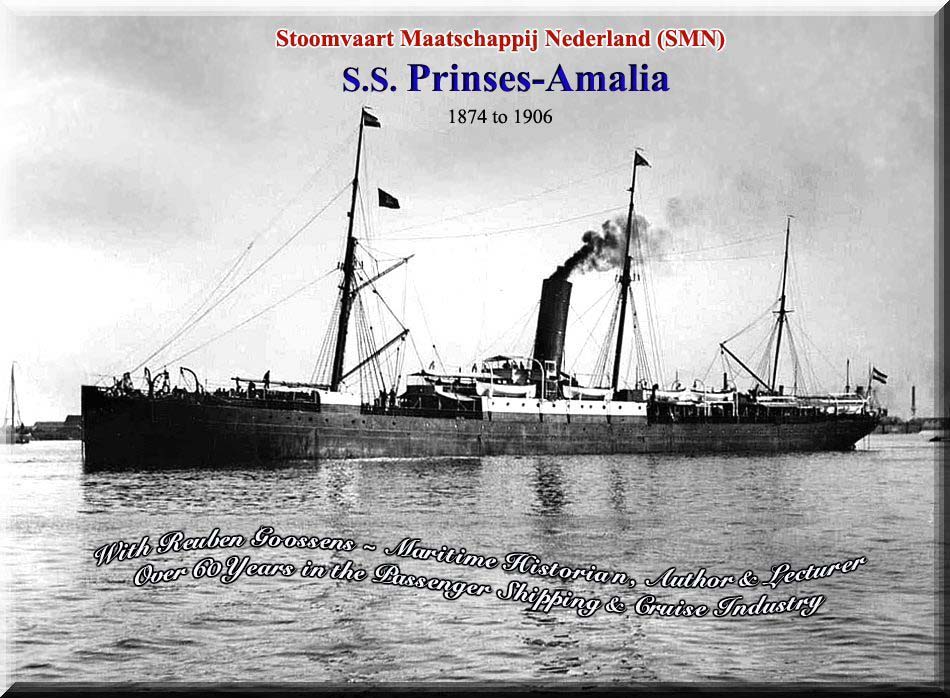
The “Stoomvaart Maatschappij
Nederland” or the “Netherlands Steamship Company” also
known as just SMN, in later years they became known by a shorter name of
the “Netherland Line” or de “Nederland
Line” in Dutch. They were one of the major Dutch shipping companies that
operated from 1870 for a full one hundred years, until 1970, when they merged
with a number of other large companies to form what would become
“Royal Nedlloyd”.
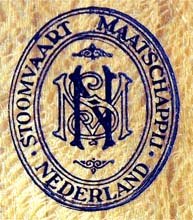
Above
& below: The Company’s logo and house flag
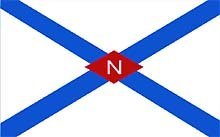
They had countless fine passenger liners with
the final two of their major ships on operation being the M.S.
Johan
van Oldenbarnevelt,
which was sold in 1963 to the Greek line to become the ill-fated T.S.M.S.
Lakonia.
With their final passenger liner being the M.S. Oranje, which was sold to Lauro
Lines in 1964 to rebuilt as the M.S. Angelino Lauro. Thereafter SMN operated
mostly cargo ships, some taking a small number of passengers.
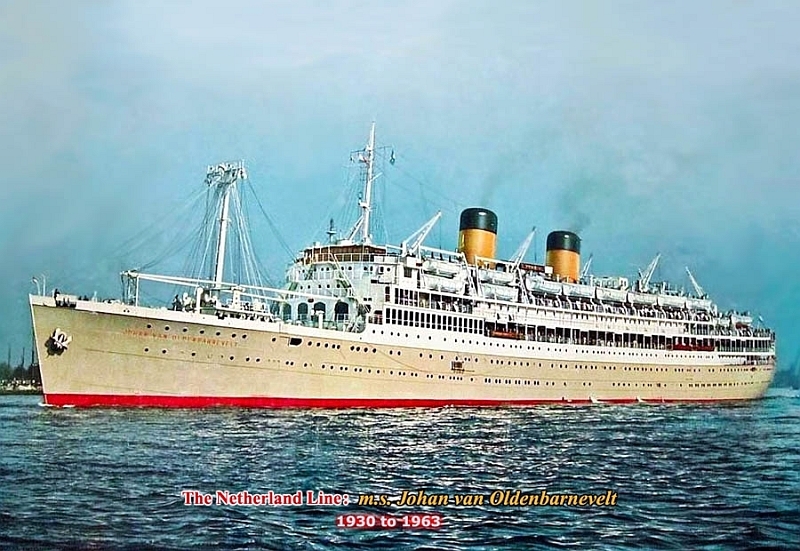
Above: M.S. Johan van Oldenbarnevelt (lovingly called the
“JVO”) Below: M.S. Oranje
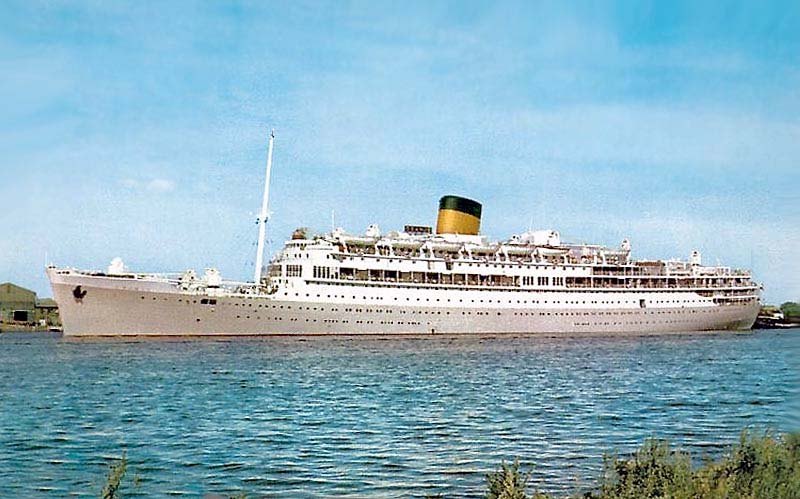
Construction
to Delivery:
“Stoomvaart Maatschappij
Nederland” (SMN) had decided to design and build a new passenger-cargo
liner for their Dutch East Indies (today’s Indonesia)
service, sailing via the Suez Canal.
But this new three mast ship complete with sails would also be a steam ship.
On June 21, 1873, SMN ordered their new ship
to be constructed by “John Elder & Company” at their Govan yard
at Glasgow,
Scotland.
She was officially named Prinses Amalia and
launched on March 19, 1874, and once in the water she was towed to the
company’s fit-out berth where she was completed. She was originally
expected to be delivered early in May 1874, but early in April
it became obvious that delivery would be delayed by at least a month, and that
the S.S.
Prinses
Amalia
would depart the Netherlands
for the Dutch East Indies
in June.
On June 6, 1874, Prinses
Amalia
undertook her trial runs on the Clyde
and she reached a good maximum speed of 12 knots. That very same evening she
departed the River Clyde and headed for her home port, and on June 10, the
brand new S.S.
Prinses
Amalia
arrived at her the home port
of Nieuwediep
(Den Helder)
the Netherlands
and she was officially delivered to SMN.
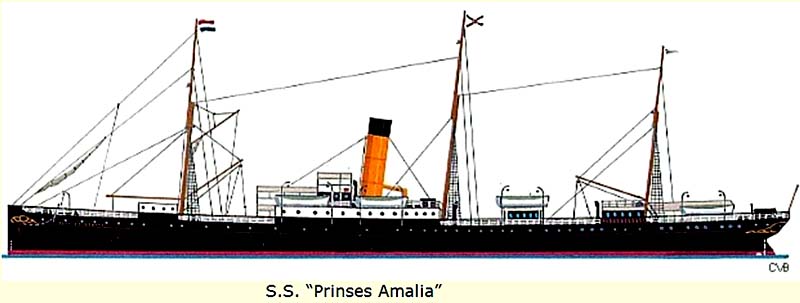
A fine
impression of the competed S.S.
Prinses
Amalia
Drawing by & ©
Mr. C.E.A van Boeckel
S.S. Prinses
Amalia was one of the earliest steam ships to operate on the Netherlands
to the Dutch East Indies
service, a service that was inaugurated by SMN in 1871, and she would spend all her sailing days
operating on this one service.
Her
Machinery:
Her compound steam engines were built by her
builders. The nominal power of her engines was 400 HP, having two direct acting
cylinders, one being 86 inch in diameter, the other being 50 inch in diameter,
each with a stroke of 3.6 ft. In addition there were also steam engines to
operate the anchor winch as well as other winches including her sails.
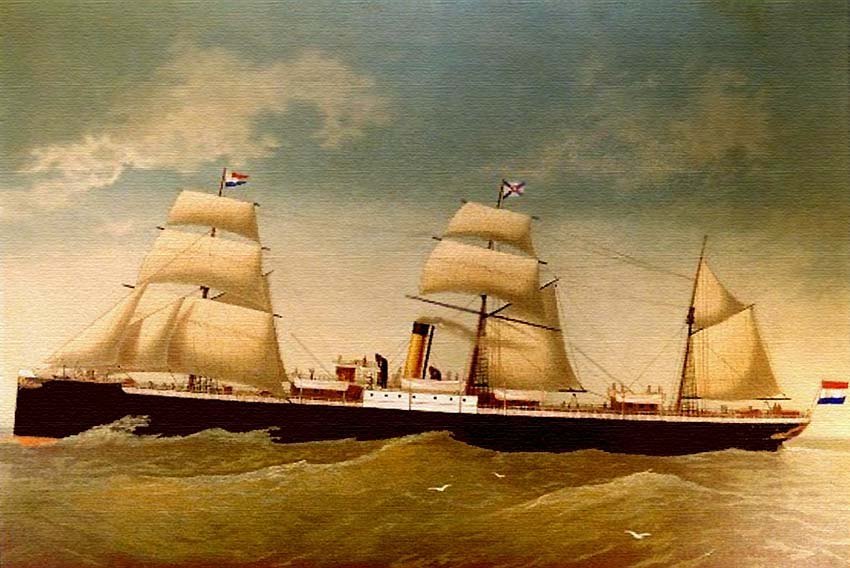
A painting
of the S.S.
Prinses
Amalia
seen under sail
Sadly the artist
is unknown
Accommodations:
S.S. Princess Amalia accommodated 76 First Class passengers, 32 passengers in Second
Class, as well as a small number in Third Class. Whilst at the bow section of
the ship contained space for soldiers, and obviously it was certainly not the
most comfortable part of the ship. Bedding for the soldier’s was very
basic, in fact they ad to sleep in hammocks. Directly aft of the
soldier’s section, was the location for the 32 second class passengers
and their cabins and public facility. These cabins were grouped around a Salon
where their meals were served and it was also their main gathering and lounging
space. There was also a pantry in this salon which was also used as a bar for
drinks. When the army was onboard, non-commanding officers would be
accommodated in Second Class.
First Class was located aft of Second Class.
All senior military officers would be housed in First Class. Their saloon was
beautifully gilded and had fine painted panels. This room had three large
tables to accommodate all 76 first-class passengers.
It was notable for the day that every first
class cabin had two washstands, this was to ensure that if there were three or
four gentlemen sharing a cabin, two of them would able to freshen themselves up
at the same time. There were also cabins for families that had internal doors
to an adjoining cabin for their children.
Maiden
Voyage and Service:
For her maiden
voyage to the Dutch East Indies the Prinses
Amalia carried many parts
of “Batavia Dock” being an iron floating dry dock, and this
was transported to the Dutch East Indies in parts, there it would be assembled
on “Untung Jawa” (Amsterdam Island).
It became known that the S.S.
Prinses
Amalia
was gong to be the largest ship ever to steam from the Netherlands,
thus her maiden voyage was a big event for SMN!
It was on June 16, 1874, that the 371.6 ft -
113.2 m long S.S. Prinses
Amalia departed from Nieuwediep (an inland
river port north east of Amsterdam)
and she headed for Southampton, then
to Naples
and via the Suez Canal bound for Batavia.
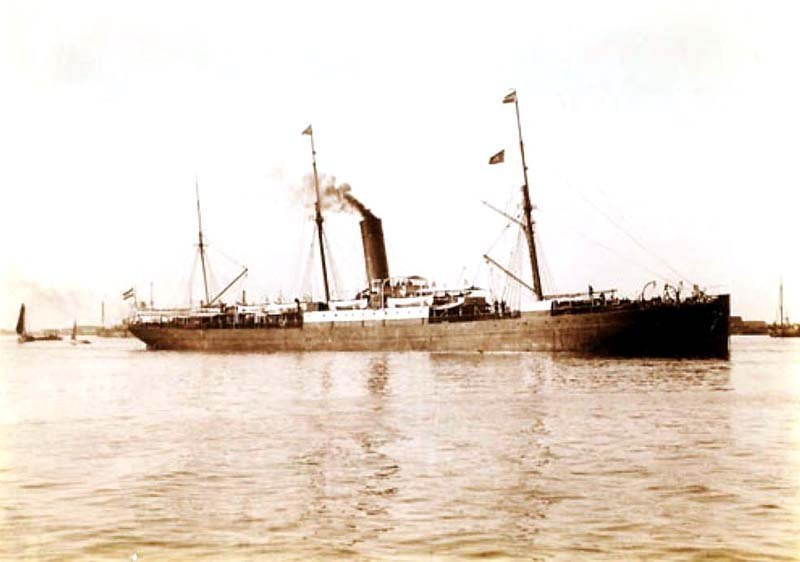
S.S. Prinses
Amalia seen on her way to Batavia
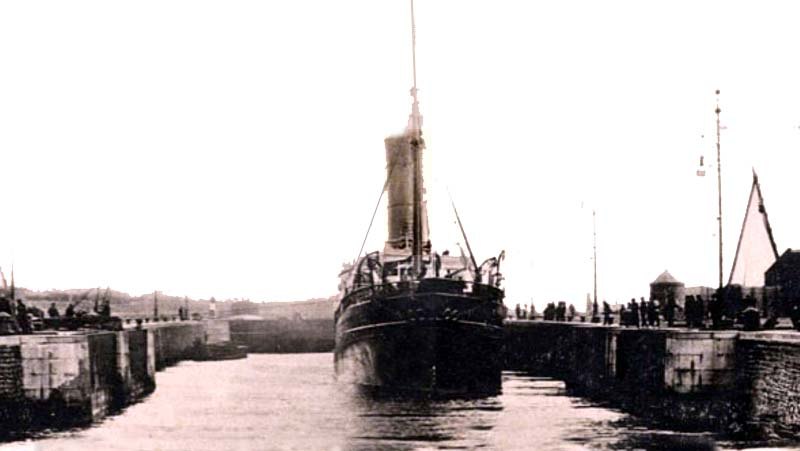
Prinses Amalia is seen departing
and in “Nieuwe
Sluis”
(a lock) at Ijmuiden
On the evening of the June 17,
1874, she arrived in Southampton
and departed again on June 19. She arrived in Naples
on June 29, from where she departed the next morning. On July 2, she arrived at Port Said
and on July 6, she departed from her anchorage at the port
of Suez.
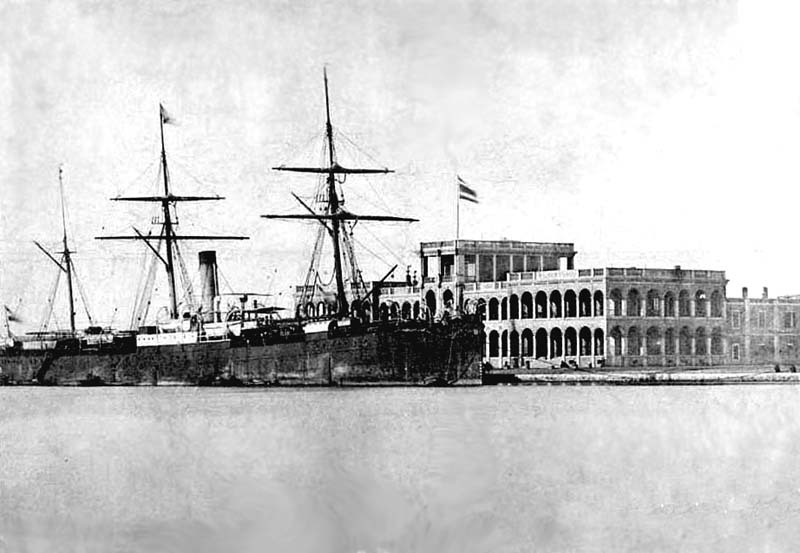
Above: The Prinses
Amalia
is seen at Port Said
& below: at anchor at the port
of Suez
But not
necessarily during her maiden voyage, but at sometime during her career
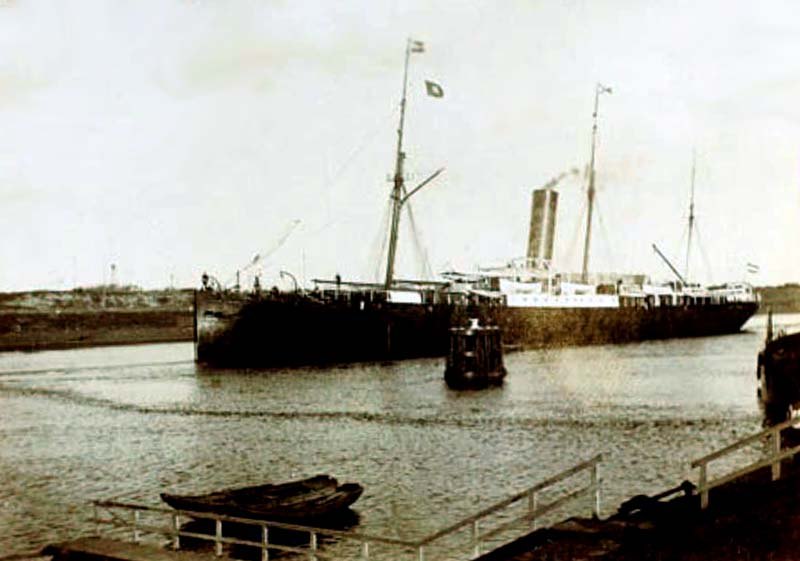
Having departed Suez
she headed for the Dutch East Indies and on July 24, the Prinses
Amalia
arrived in Padang.
Then on July 31, she arrived in Batavia.
It was an excellent and a fast voyage, for without all the ports of call, this
would have been the fastest voyage from Nieuwediep to Batavia
to that date.
During her many voyages she carried many
notable people, but also one who became the most infamous personage of WW1.
This was the woman who became known as Mata
Hari,
who travelled with her husband who was a soldier and a Captain from
Holland bound
for Batavia
on May 1, 1897. Of course she became the evil spy who worked for the Germans.
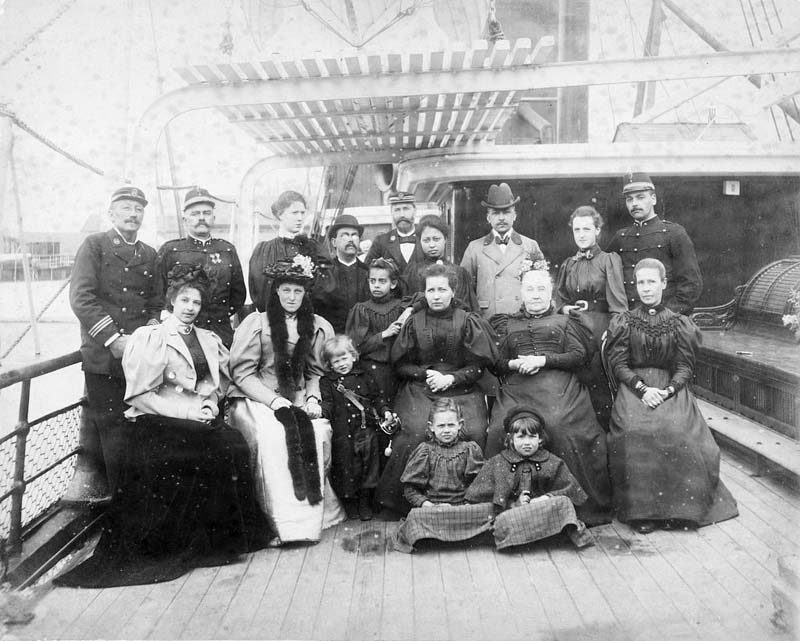
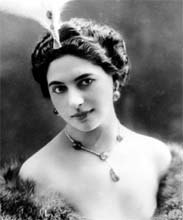
Mata Hari seen in her past career as an exotic dancer
Above: Mati
Hari’s
actual name was; Margaretha Geertruida MacLeod-Zelle (1876-1917), she is seen front
row far left and standing behind her is her husband Captain Rudolph
John
MacLeod
on the S.S.
Prinses
Amalia
whilst on their way to the Dutch East Indies.
I was told that this photo may have been taken whilst the ship was berthed in Southampton.
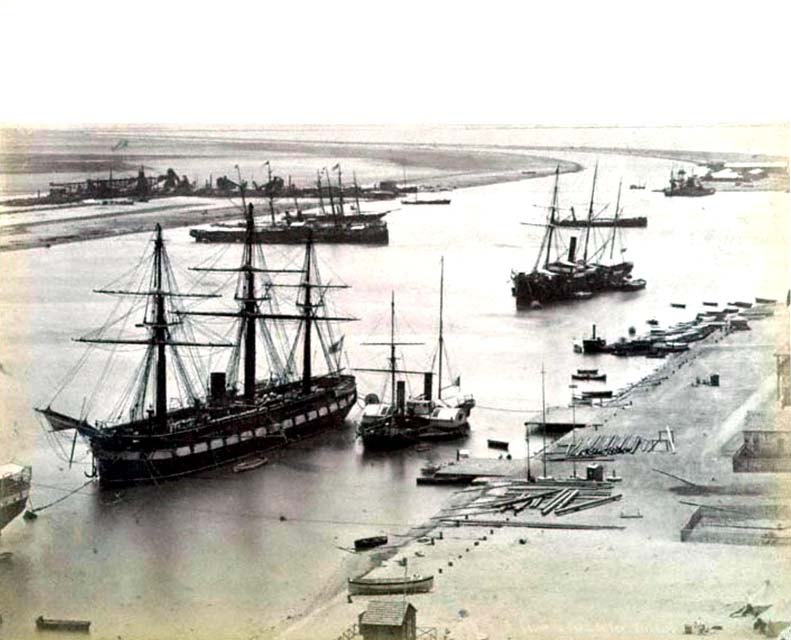
The Prinses
Amalia
is seen on the right at the Suez Canal
staging area
Her
Final Years:
S.S.
Prinses Amelia
continued her Netherland’s to Batavia service for a good 29 years,
however as there was unrest in the Dutch
East Indies, in 1903 SMN decided to lay-up their
fine ship, Prinses
Amalia
and use her as a reserve ship, but eventually it was decided by the company to
sell her. It was in 1906 that this much loved ship was sold to be broken up to
“J.J. King & Son”.
However, they sold her on to; “L.
Pittaluga”
being the owner of an Italian breaker’s yard, who renamed her “Amalia” for her final voyage to
their yard at Genoa.
Breaking up on this remarkable liner commenced on November 28, 1906 and she was
completely dismantled by January 1907.
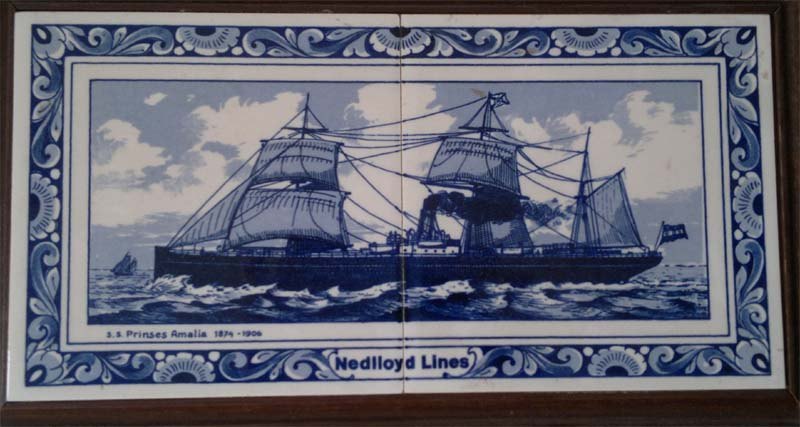
A commemorative
Delft Blue tiles of the S.S. Prinses Amalia
S.S. Prinses
Amalia Specifications and details:
Name: Prinses
Amalia.
. Amelia
1906.
Owner: “Stoomvaart
Maatschappij
Nederland”
1874-1906.
. “J.J. King & Son” 1906.
. “L.
Pittaluga”
1906.
Constructed by: John
Elder & Co, on the River Clyde, Glasgow
Scotland.
Yard number: 166.
Cost: 984,840 Dutch
guilders.
Laid down: August 14, 1873.
Launched: March
19, 1874.
Maiden
Voyage: June 16, 1874.
Class and
type: All Iron Passenger
Cargo liner.
Tonnage: 3,480 GRT 2,581 NET.
Length: 371.6 ft - 113.2 m.
Beam: 39.9 ft - 12.1 m.
Draught: 22.2 ft - 6.8 m.
Installed power: 1,600
ihp (1,200 kW) (as built).
Propulsion: 2-cylinder 50 & 86
in × 42 in (1,300 & 2,200 mm × 1,100 mm) steam engine.
From 1892: Single screw,
triple-expansion 3-cylinder steam engine by Royal Company “De Schelde”
of Vlissingen.
Propeller: Single screw.
Sail plan: 3-masted barque.
Speed: 11.5 knots, 12
knots maximum.
Accommodations: 76 First, 32 Second and some
Third Class passengers as well as space for soldiers.
Cargo space: 3,500 tons.
Out of
service & sold: 1906.
Renamed: Amalia
November 1906.
Fate: Demolition
commenced November 28, 1906 & was completed January 1907.
Remembering
the S.S.
Prinses
Amalia
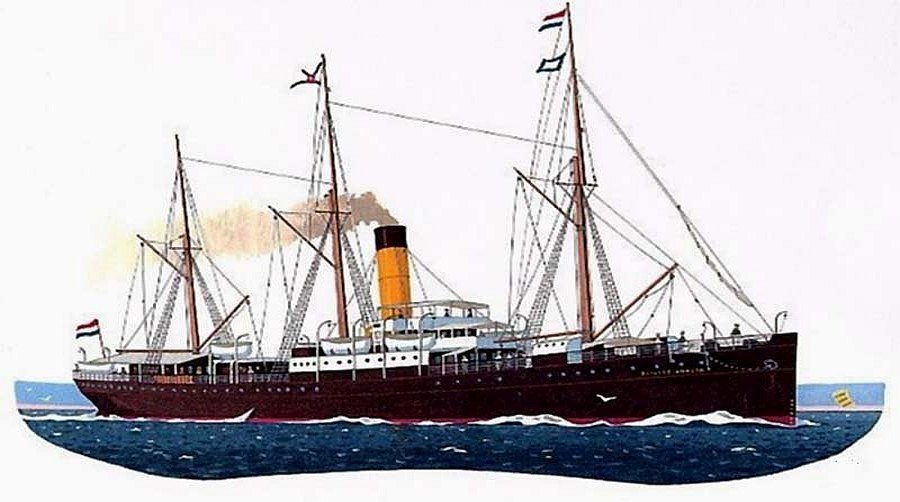
By artist Nico
Keus
Also visit the S.S. Prinses Juliana
and the M.S. Johan van Oldenbarnevelt and the M.S. Oranje features
***************************
“Blue Water Liners sailing to the distant
shores.
I watched them come, I watched them go and I watched them die.”
ENTER
OUR … ssMaritime
Main INDEX
Where
you will discover well over 1,360 Classic Passenger & Passenger-Cargo Liners!
The Author
has been in Passenger Shipping & the Cruise Industry for over 60 years!
For interest: Sadly an email service to ssMaritime is no
longer available, due to the author’s old age and chronic illness as well
as being disabled, etc. In the past ssMaritime received well over 120 emails
per day, but Mr.
Goossens
can no longer handle same. He sincerely regrets this!
ssMaritime.com & ssMaritime.net
Where
the ships of the past make history & the story of the 1914 built MV Doulos
Please
Note: ssmaritime and associated sites are
100% non-commercial and the author does not seek funding or favours and never
have and never will.
Photographs
on ssmaritime and associate pages are either by the author or from the
author’s private collection. In addition there are some images and
photographs that have been provided by Shipping Companies or private
photographers or collectors. Credit is given to all contributors, however,
there are some photographs provided to me without details regarding the
photographer or owner concerned.
ssMaritime is owned & © Copyright
by Reuben
Goossens
- All Rights Reserved
















